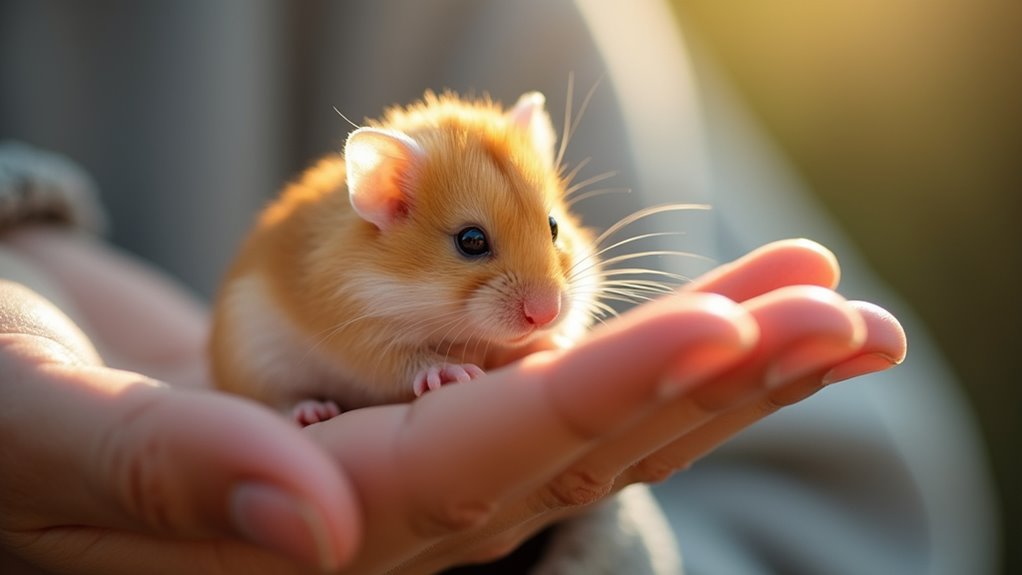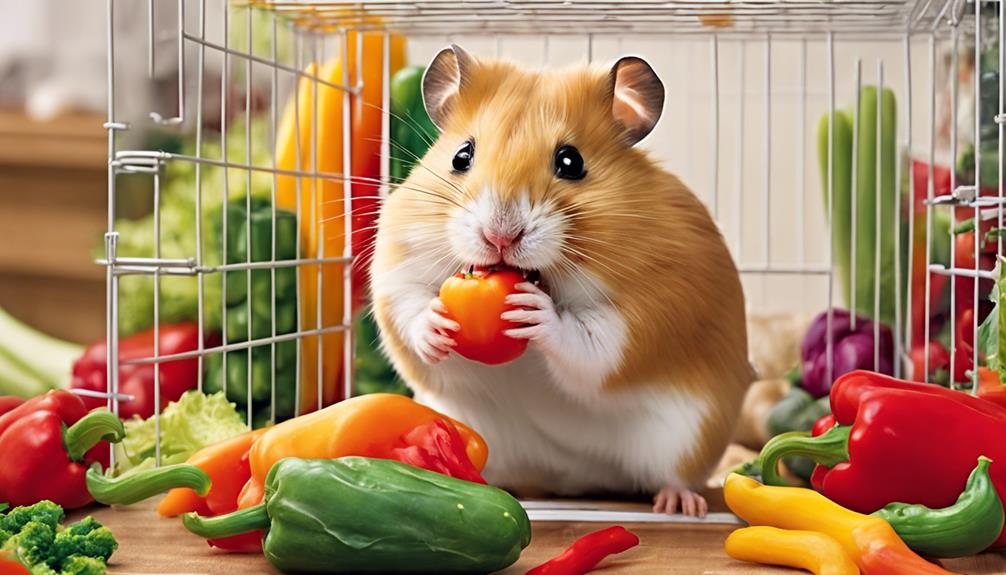To tame your hamster, establish a consistent routine and create a calm environment that builds trust. Handle your hamster gently with slow, deliberate movements and allow it to approach you at its own pace. Spend time near the cage, offering treats and talking softly to become familiar. Keep handling sessions short initially and increase gradually. Patience and gentle persistence will help your hamster feel secure, and there’s much more to discover to strengthen your bond further.
Key Takeaways
- Establish a consistent routine with regular handling and feeding to build familiarity and positive associations.
- Create a comfortable, enriched cage environment to reduce stress and encourage exploration.
- Approach your hamster gently with slow movements, allowing it to approach at its own pace.
- Handle your hamster daily, supporting its body fully and gradually increasing interaction time.
- Be patient and attentive to stress cues, adjusting your approach to foster trust and a strong bond.

Handling and bonding with your hamster is essential for building trust and ensuring a happy, healthy relationship. When you start this process, it’s important to consider your hamster’s daily routines and environment. Establishing consistent feeding routines helps your hamster recognize you as a source of comfort and care. Offer treats at regular times, and gently introduce your hand during feeding so your hamster associates your presence with positive experiences. This consistency creates a foundation of trust that makes handling easier over time.
Consistent routines and gentle handling foster trust and a healthy bond with your hamster.
Your cage setup plays a significant role in your hamster’s comfort and willingness to bond. A well-designed cage provides ample space, hiding spots, and enrichment items that reduce stress. When your hamster feels safe and secure in its environment, it’s more receptive to human interaction. Before handling, spend time near the cage, talking softly and offering treats through the bars. This allows your hamster to become familiar with your scent and presence, easing the changeover to direct handling. Avoid sudden movements or loud noises, which can startle your pet and hinder bonding efforts.
Once your hamster seems comfortable with your presence, start the handling process gently. Use slow, deliberate movements and let your hamster come to you. Don’t force interaction; instead, allow your pet to approach at its own pace. Begin by scooping your hamster carefully with both hands, supporting its body fully, and holding it close to your chest. During these initial handling sessions, keep them brief—just a few minutes at first—and gradually increase the duration as your hamster gains confidence. Always be gentle, avoiding squeezing or gripping too tightly, which can cause fear or injury. Building a bond through patience is crucial for a trusting relationship.
Consistency is key to successful bonding. Handle your hamster regularly, ideally daily, so it becomes accustomed to your touch and voice. Incorporate handling into your feeding routines, making it a natural part of your daily interactions. Over time, your hamster will associate your presence with safety and affection, strengthening your bond. Remember, patience is essential; some hamsters take longer to trust than others. If your pet shows signs of stress or fear, give it space and try again later. Additionally, understanding animal behavior can help you interpret your hamster’s reactions and adjust your approach accordingly. With gentle persistence and a calm approach, you’ll foster a trusting relationship that benefits both of you and leads to a happy, well-bonded hamster.
Frequently Asked Questions
How Often Should I Clean My Hamster’S Cage?
You should clean your hamster’s cage at least once a week to maintain proper hygiene. Following a regular cleaning schedule helps prevent odors and keeps your pet healthy. During cage maintenance, spot clean daily by removing soiled bedding and leftover food. Deep clean the entire cage regularly, ensuring all surfaces are sanitized. Consistent cleaning promotes a clean environment, reduces stress, and encourages your hamster’s well-being and happiness.
What Should I Feed My Hamster for a Healthy Diet?
Feeding your hamster is like giving it a tiny, nutritious feast. You should provide a balanced diet with high-quality hamster pellets as the main course. Add nutritious treats like sunflower seeds and small amounts of fresh vegetables, which keep your pet healthy and happy. Avoid sugary or processed foods, and always offer fresh water. This variety guarantees your hamster gets the essential nutrients for a vibrant, energetic life.
How Can I Tell if My Hamster Is Stressed?
You can tell your hamster is stressed by observing its behavior cues and environmental signs. If it’s biting, squeaking excessively, or hiding more than usual, these are clear stress signals. Also, watch for excessive grooming or lethargy. Changes in cage environment, loud noises, or sudden handling can trigger stress. You should create a calm, consistent environment and monitor your hamster’s reactions to guarantee it feels safe and relaxed.
When Is the Best Time to Handle My Hamster?
You might find that handling your hamster during your morning routine helps build trust, as they’re naturally more active and curious then. Coincidentally, this time aligns with their alertness, making it ideal for bonding. Avoid bedtime handling, as your hamster may be tired or stressed. By choosing mornings, you create a positive, relaxed environment, fostering a stronger bond and ensuring your hamster feels safe and comfortable with you.
What Toys Are Safe and Engaging for Hamsters?
You want safe, engaging toys for your hamster, so opt for novel chew toys made from natural materials like wood or cardboard. DIY enrichment activities are great too, such as creating tunnels or puzzle feeders from household items. These toys keep your hamster active and mentally stimulated while ensuring safety. Always supervise playtime to prevent any accidents, and regularly check toys for wear and tear to maintain a safe environment.
Conclusion
So, after all that handling and bonding, you might think your hamster now trusts you completely. But don’t be surprised if it suddenly bolts back into its cage, leaving you with a tiny, fluffy reminder that even the tamest hamster still has a wild streak. It’s a funny kind of friendship—one where patience and a little bit of irony are your best tools. After all, taming a hamster is a lesson in humility, wrapped in fur.










